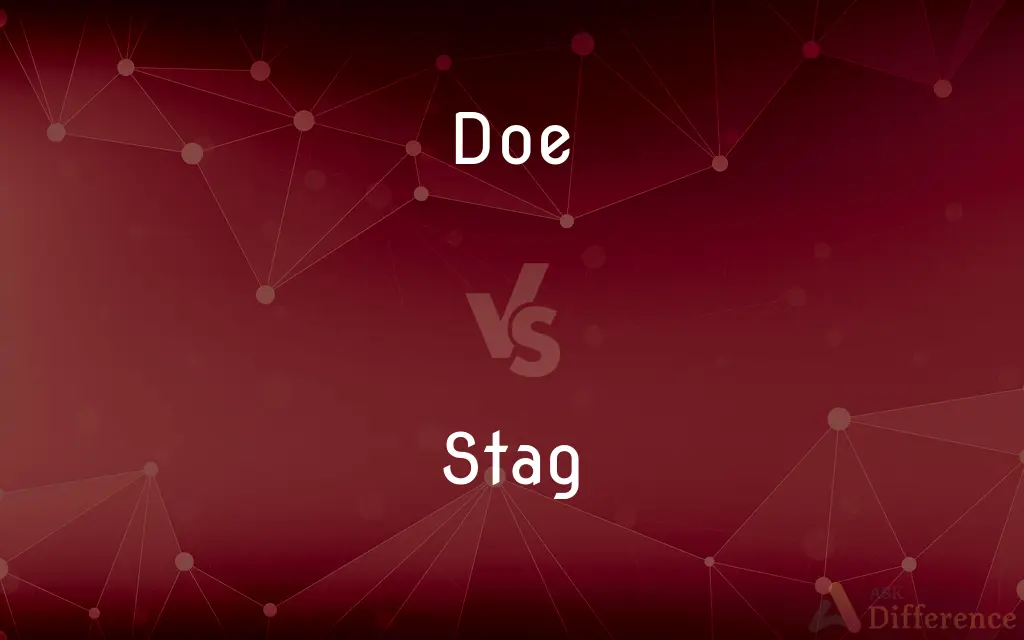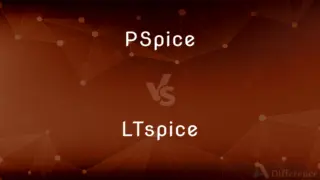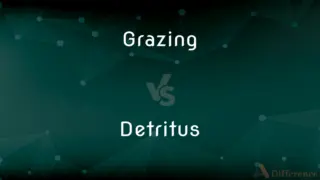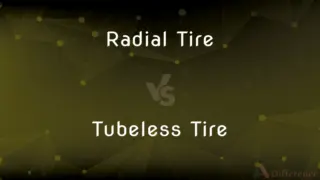Doe vs. Stag — What's the Difference?
By Tayyaba Rehman & Urooj Arif — Updated on April 27, 2024
A doe is a female deer, generally smaller and without antlers, while a stag is a male deer, characterized by its larger size and distinctive antlers.

Difference Between Doe and Stag
Table of Contents
ADVERTISEMENT
Key Differences
A doe refers to the female of deer species, known for their smaller stature and lack of antlers, which contributes to their more elusive nature in the wild. On the other hand, a stag is essentially a mature male deer, often larger in size and sporting a set of antlers that are shed and regrown annually, making them more conspicuous during the mating season.
While does are primarily responsible for the rearing of fawns, demonstrating more secretive behavior to protect their young, stags are more involved in territorial fights and are often seen leading or defending harems during the rutting season.
In terms of behavior, does tend to be more cautious and are quicker to flee from threats, a survival trait that protects their young. In contrast, stags are more aggressive and confrontational, especially in the presence of rivals or threats to their dominance.
Regarding their roles in the ecosystem, does contribute by maintaining the deer population through reproduction. Whereas stags play a crucial role in selecting the fittest genes for the next generation through competition during the mating season.
In cultural symbolism, does are often associated with gentleness and nurturing qualities, commonly featured in folklore and children's stories as caring and protective figures. Stags, however, symbolize strength and virility, frequently depicted in myths and coats of arms, representing leadership and prowess.
ADVERTISEMENT
Comparison Chart
Physical Characteristics
Smaller, no antlers
Larger, prominent antlers
Behavior
Cautious, protective of young
Aggressive, territorial
Role in Reproduction
Rears fawns
Competes for mating rights
Symbolism
Gentleness, nurturing
Strength, leadership
Common in Cultural Representation
Folklore, children's stories
Myths, heraldry
Compare with Definitions
Doe
A term used in hunting to specify gender.
The hunters were required to identify whether their target was a doe or a stag.
Stag
A mature male deer.
The majestic stag stood proudly at the forest's edge.
Doe
In literature, often symbolizes care and protection.
The doe in the story protected her young from the dangers of the forest.
Stag
Symbolizes strength in heraldry.
The family crest featured a stag to represent resilience and fortitude.
Doe
In population management, refers to the reproductive potential.
Managing doe populations helps control overall deer numbers.
Stag
In wildlife management, denotes a breeding male.
Wildlife conservationists track stag movements to study mating patterns.
Doe
Used metaphorically to describe gentleness.
She is as gentle as a doe with her students.
Stag
The adult male of various deer, especially the red deer.
Doe
A female deer, especially a female roe, fallow deer, or reindeer.
Stag
An animal, especially a pig, castrated after reaching sexual maturity.
Doe
A female deer.
Stag
A person who attends a social gathering unaccompanied by a partner, especially a man who is unaccompanied by a woman.
Doe
The female of various other mammals, such as antelopes, kangaroos, mice, or rabbits.
Stag
A social gathering for men only.
Doe
A female deer; also used of similar animals such as antelope, (less commonly goat as nanny is also used).
Stag
Of or for men only
A stag party.
Doe
A female rabbit.
Stag
Pornographic
Stag films.
Doe
A female hare.
Stag
Unaccompanied
Went to the dance stag.
Doe
A female squirrel.
Stag
To attend a social gathering unaccompanied by a partner. Used especially of men.
Doe
A female kangaroo.
Stag
(countable) An adult male deer.
Doe
A female deer or antelope; specifically, the female of the fallow deer, of which the male is called a buck. Also applied to the female of other animals, as the rabbit. See the Note under Buck.
Stag
(countable) A colt, or filly.
Doe
The federal department responsible for maintaining a national energy policy of the United States; created in 1977
Stag
A romping girl; a tomboy.
Doe
Mature female of mammals of which the male is called `buck'
Stag
(countable) An improperly or late castrated bull or ram – also called a bull seg (see note under ox).
Stag
An outside irregular dealer in stocks, who is not a member of the exchange.
Stag
One who applies for the allotment of shares in new projects, with a view to sell immediately at a premium, and not to hold the stock.
Stag
An unmarried man; a bachelor; a man not accompanying a woman at a social event.
A stag dance; a stag party; a stag bar
Stag
(countable) A social event for men held in honor of a groom on the eve of his wedding, attended by male friends of the groom; sometimes a fundraiser.
The stag will be held in the hotel's ballroom.
Stag
Guard duty.
Stag
(countable) A stag beetle (family Lucanidae).
Stag
(countable) The Eurasian wren, Troglodytes troglodytes.
Stag
To act as a "stag", an irregular dealer in stocks.
Stag
(transitive) To watch; to dog, or keep track of.
Stag
Of a man, attending a formal social function without a date.
My brother went stag to prom because he couldn't find a date.
Stag
The adult male of the red deer (Cervus elaphus), a large European species closely related to the American elk, or wapiti.
Stag
A colt, or filly; also, a romping girl.
Stag
A castrated bull; - called also bull stag, and bull seg. See the Note under Ox.
Stag
An outside irregular dealer in stocks, who is not a member of the exchange.
Stag
The European wren.
Stag
To act as a "stag," or irregular dealer in stocks.
Stag
To watch; to dog, or keep track of.
Stag
Male red deer
Stag
Adult male deer
Stag
Attend a dance or a party without a female companion
Stag
Give away information about somebody;
He told on his classmate who had cheated on the exam
Stag
Watch, observe, or inquire secretly
Stag
A term used in social events (stag party).
He celebrated his last days of bachelorhood at his stag party.
Stag
In stories, often a character of leadership.
The stag in the fable led the other animals to safety.
Common Curiosities
Can does ever grow antlers?
Very rarely, some does may develop antlers due to hormonal imbalances, but it is not typical.
What primarily distinguishes a doe from a stag?
A doe is a female deer without antlers, while a stag is a male deer with antlers.
What is the lifespan of a doe compared to a stag?
Lifespans can vary, but both generally live around the same time unless influenced by external factors like predation or hunting.
Are does or stags larger?
Stags are generally larger than does.
Why do stags have antlers?
Antlers are used by stags to fight for territory and attract females during the breeding season.
Are stags or does more aggressive?
Stags are generally more aggressive, especially during the rutting season.
How do does contribute to the deer population?
Does contribute by giving birth and rearing the young, directly affecting population dynamics.
How are does portrayed in cultural stories?
Does are often portrayed as nurturing and protective characters.
What role do does play during the mating season?
Does select mates based on the fitness displayed by stags, influencing genetic diversity.
What does the presence of a stag in heraldry signify?
It symbolizes strength, virility, and leadership.
Share Your Discovery

Previous Comparison
Flip vs. Reverse
Next Comparison
Decision vs. ResolutionAuthor Spotlight
Written by
Tayyaba RehmanTayyaba Rehman is a distinguished writer, currently serving as a primary contributor to askdifference.com. As a researcher in semantics and etymology, Tayyaba's passion for the complexity of languages and their distinctions has found a perfect home on the platform. Tayyaba delves into the intricacies of language, distinguishing between commonly confused words and phrases, thereby providing clarity for readers worldwide.
Co-written by
Urooj ArifUrooj is a skilled content writer at Ask Difference, known for her exceptional ability to simplify complex topics into engaging and informative content. With a passion for research and a flair for clear, concise writing, she consistently delivers articles that resonate with our diverse audience.















































